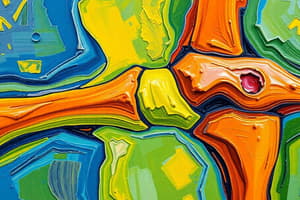Podcast
Questions and Answers
Which type of joint allows virtually no movement?
Which type of joint allows virtually no movement?
- Synovial joints
- Vertebral joints
- Fibrous joints (correct)
- Cartilaginous joints
Which joint type operates as a hinge, essentially rotating about only one axis?
Which joint type operates as a hinge, essentially rotating about only one axis?
- Biaxial joint
- Uniaxial joint (correct)
- Multiaxial joint
- Synovial joint
What are the most important features of synovial joints?
What are the most important features of synovial joints?
- Low friction and large range of motion (correct)
- High friction and limited range of motion
- Large friction and limited range of motion
- High friction and considerable movement
What allows movement about all three perpendicular axes that define space?
What allows movement about all three perpendicular axes that define space?
Which part of the nervous system is responsible for slowing down the heart rate?
Which part of the nervous system is responsible for slowing down the heart rate?
What is the structure that regulates the muscle actions?
What is the structure that regulates the muscle actions?
What type of fiber is characterized by slow contraction and high resistance to fatigue?
What type of fiber is characterized by slow contraction and high resistance to fatigue?
During which phase of an action potential does depolarization occur?
During which phase of an action potential does depolarization occur?
What do muscle spindles indicate?
What do muscle spindles indicate?
What is the function of proprioceptors?
What is the function of proprioceptors?
What happens when a load increases on a muscle?
What happens when a load increases on a muscle?
What is the knee jerk reflex an example of?
What is the knee jerk reflex an example of?
Flashcards are hidden until you start studying
Study Notes
Types of Joints
- Synarthrosis joints allow virtually no movement and are typically found in areas like the skull.
- Hinge joints operate as a hinge, enabling movement primarily in one plane, such as the elbow and knee.
Synovial Joints
- Synovial joints feature key characteristics like a synovial membrane, synovial fluid, joint capsule, and articular cartilage.
- These components facilitate smooth movement and reduce friction between bones.
Movement and Axes
- Ball-and-socket joints permit movement around all three perpendicular axes, allowing rotation in multiple directions.
Nervous System Regulation
- The parasympathetic nervous system is responsible for slowing down the heart rate, promoting a state of rest and relaxation.
Muscle Regulation
- The structure that regulates muscle actions is the neuromuscular junction, where motor neurons connect with muscle fibers to initiate contraction.
Muscle Fiber Types
- Type I muscle fibers are characterized by slow contraction speed and high resistance to fatigue, making them suitable for endurance activities.
Action Potential Phases
- Depolarization occurs during the rapid influx of sodium ions, which is a key phase of the action potential, leading to muscle contraction.
Muscle Spindles
- Muscle spindles indicate changes in muscle length and the rate of stretch, providing essential feedback for coordinating movements.
Proprioceptors
- Proprioceptors function to sense body position and movement, helping the body maintain balance and coordination.
Load Increase Effects
- When a load increases on a muscle, it activates a greater number of motor units, leading to an increase in muscle contraction strength (known as recruitment).
Reflexes
- The knee jerk reflex is an example of a monosynaptic reflex arc, demonstrating a direct connection between sensory and motor neurons for quick responses.
Studying That Suits You
Use AI to generate personalized quizzes and flashcards to suit your learning preferences.



